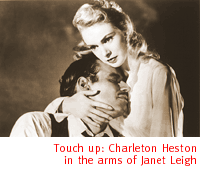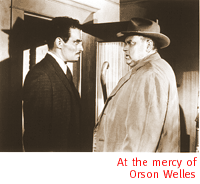

|

Orson Welles' 'Touch Of Evil' Is Recut As The Master Intended.
By Stacey Richter
ORSON WELLES' masterpiece, Touch of Evil, flopped
when it was released in 1958, but it has since come to be considered
one of the great films of all time. Film geeks in particular have
a love for Welles' loud, trashy style--a garish sort of film noir--and
have heralded Touch of Evil as a marvelous synthesis of
high and low art where Shakespearean themes and rich imagery meet
sleazy punks in leather jackets. A terrific new re-edited version
of Touch of Evil returns it to the big screen in all of
its glory, and restores it to the shape the director originally
intended.
 Welles was an anomalous figure in Hollywood, an Easterner prodigy
with little finesse at playing the system. He was notoriously
hard to work with and had legendary difficulties finishing projects,
often losing interest during post-production. He'd often abandon
one film for the next, or wander off to Mexico. Though he was
heralded as a genius, no one in Hollywood seemed to much like
him for it, and film studios seemed unaccountably pleased to mangle
his efforts--including Touch of Evil, which was taken out
of his hands during editing by Universal Studios' head Edward
Muhl in 1957.
Welles was an anomalous figure in Hollywood, an Easterner prodigy
with little finesse at playing the system. He was notoriously
hard to work with and had legendary difficulties finishing projects,
often losing interest during post-production. He'd often abandon
one film for the next, or wander off to Mexico. Though he was
heralded as a genius, no one in Hollywood seemed to much like
him for it, and film studios seemed unaccountably pleased to mangle
his efforts--including Touch of Evil, which was taken out
of his hands during editing by Universal Studios' head Edward
Muhl in 1957.
 Welles responded to the studio's version by writing Muhl a 58-page
memo setting forth his vision of the film in detail. Muhl ignored
it. For years, what we have been seeing is Universal's corporate
cut of Touch of Evil, which was believed to be more intelligible
than Welles'. Apparently, Muhl was thrown by Welles' use of cross-cutting--switching
back and forth between scenes of Vargas, a high-level Mexican
policeman (Charlton Heston) and his bride Susan (Janet Leigh)
as they each have sleazy misadventures on different sides of the
U.S./Mexican border. Other significant changes were also made.
A soundtrack by Henry Mancini and opening credits were added to
the famous opening scene--a three-minute, 20-second uninterrupted
crane shot--and some additional footage was added.
Welles responded to the studio's version by writing Muhl a 58-page
memo setting forth his vision of the film in detail. Muhl ignored
it. For years, what we have been seeing is Universal's corporate
cut of Touch of Evil, which was believed to be more intelligible
than Welles'. Apparently, Muhl was thrown by Welles' use of cross-cutting--switching
back and forth between scenes of Vargas, a high-level Mexican
policeman (Charlton Heston) and his bride Susan (Janet Leigh)
as they each have sleazy misadventures on different sides of the
U.S./Mexican border. Other significant changes were also made.
A soundtrack by Henry Mancini and opening credits were added to
the famous opening scene--a three-minute, 20-second uninterrupted
crane shot--and some additional footage was added.
The new version was prepared according to specifications in Welles'
memo by editor Walter Murch, along with Rick Schmidlin and film
critic Jonathan Rosenbaum, and at first glance, it isn't radically
different from the old. The most prominent change is in the opening
sequence, which, without Mancini's soundtrack, is an amazing collage
of radio and street sounds that merge into one another as the
camera zips along a street in a seedy border town. The shot begins
with a hood slipping a bomb into the trunk of a car, tracking
the car in a single uninterrupted take over the border. Walking
beside the car is Vargas and his new American bride. They kiss,
and the car explodes.
The freshly wed Mr. and Mrs. Vargas are separated for the rest
of the movie. In the restored version, we jump back and forth
between Leigh and Heston, as husband diligently investigates the
explosion, while wife goes about being perkily victimized by thugs.
Curiously, despite the objections of the studio in 1957, the film
is more intelligible to a modern audience than the old version.
The cross-cutting technique Welles advocated might have been daring
once, but it's so common in films today that the technique is
invisible. Though I wouldn't ever have called Touch of Evil
boring, the re-edited version has a momentum the earlier version
lacked.
 If you haven't seen Touch of Evil a gazillion times, a
lot of the changes are hard to spot, though they make their presence
felt. What I noticed was how certain aspects of the story come
forward in the new cut. Investigating the crime on the American
side is the corrupt cop Hank Quinlan--a huge and gouty Welles,
downing candy bars and wearing the largest raincoat I've ever
seen--along with his fawning sidekick Pete Menzies (Joseph Calleia).
Menzies idolizes Quinlan, and now you can more clearly see his
mounting disappointment as he realizes that his beloved idol is,
well, evil. The strange, thwarted separation of the just-married
Vargases is more apparent too, as scenes alternate between them.
Mike Vargas spends his wedding night chasing thugs with a corrupt
American policeman while Susan is raped by a gang of leather-clad
teenagers hopped up on "mary jane," a drug they like
to "mainline."
If you haven't seen Touch of Evil a gazillion times, a
lot of the changes are hard to spot, though they make their presence
felt. What I noticed was how certain aspects of the story come
forward in the new cut. Investigating the crime on the American
side is the corrupt cop Hank Quinlan--a huge and gouty Welles,
downing candy bars and wearing the largest raincoat I've ever
seen--along with his fawning sidekick Pete Menzies (Joseph Calleia).
Menzies idolizes Quinlan, and now you can more clearly see his
mounting disappointment as he realizes that his beloved idol is,
well, evil. The strange, thwarted separation of the just-married
Vargases is more apparent too, as scenes alternate between them.
Mike Vargas spends his wedding night chasing thugs with a corrupt
American policeman while Susan is raped by a gang of leather-clad
teenagers hopped up on "mary jane," a drug they like
to "mainline."
And all the original splendor of Touch of Evil looks even
better in the restored print. The black-and-white photography
is unforgettable, tottering on the edge of German Expressionism
in its starkness. The story and acting are hard to beat, too.
Welles visits his classic theme of the great man brought low,
Lear-like, with an uncanny sense of corruption seeping from his
every mumble. Heston is annoying, but the rest of the actors are
great, walking the delicate line between big and over-the-top
that makes Touch of Evil brassy without ever being cartoon-like.
This is a film that shouldn't be missed.
Touch Of Evil is playing at the Loft cinema.

|
 |





